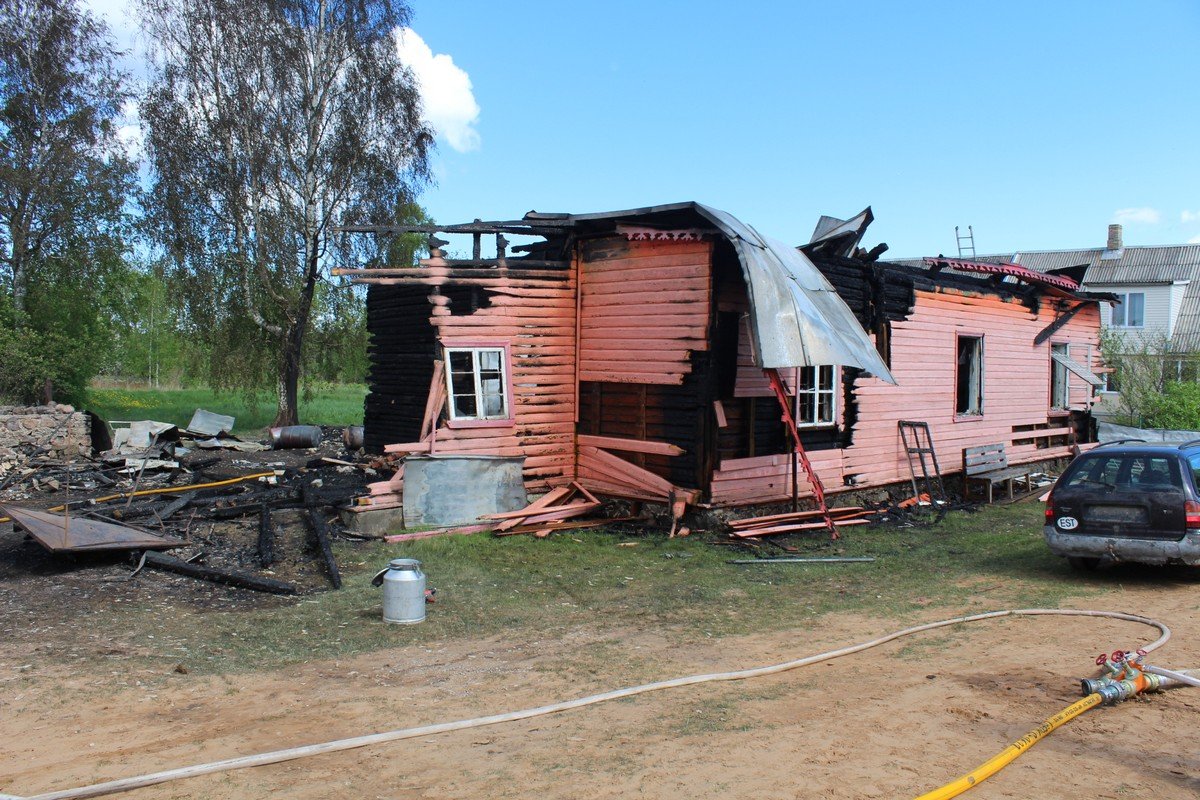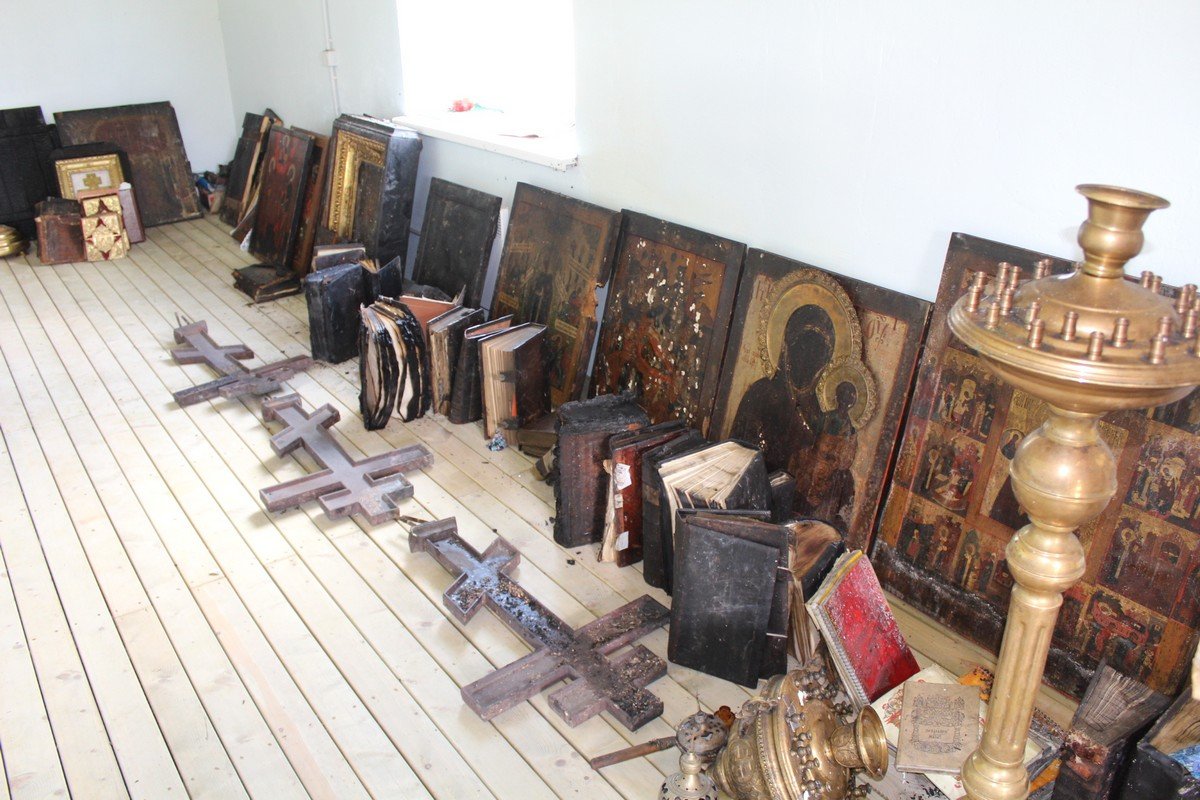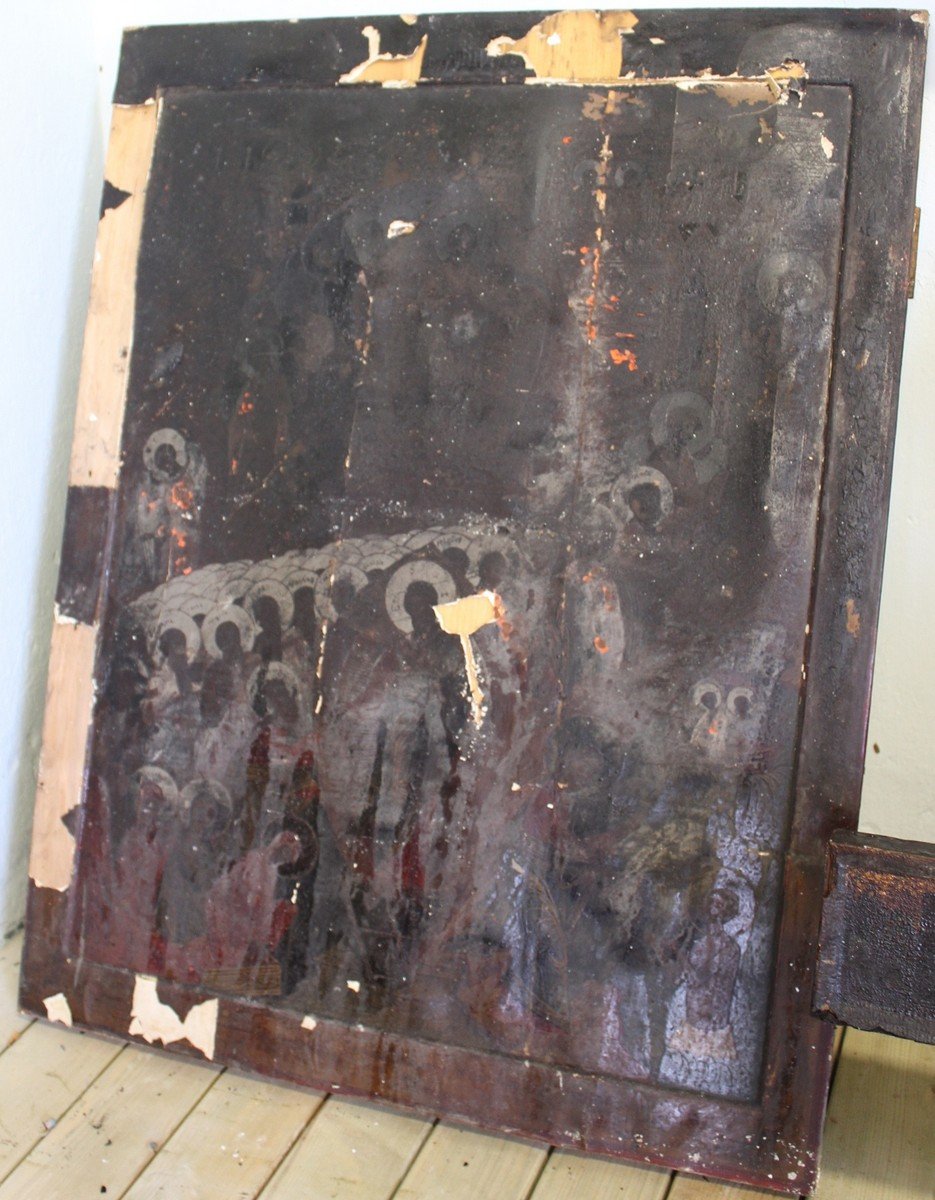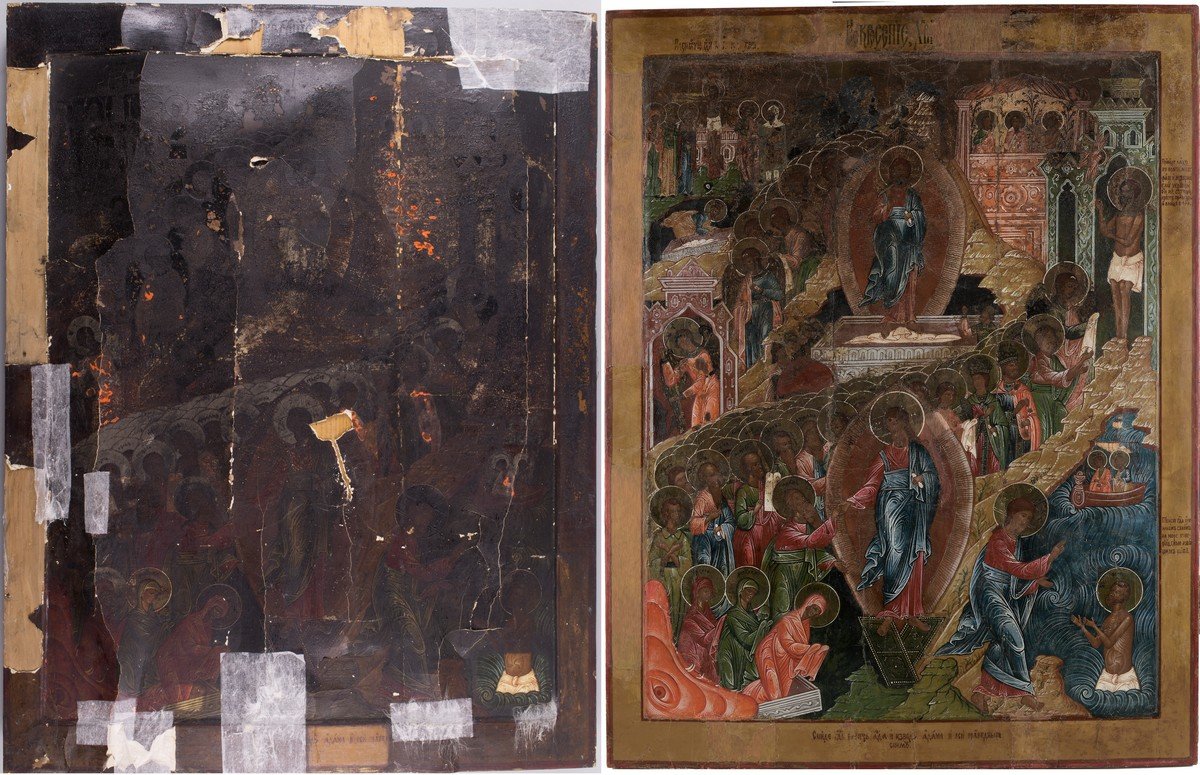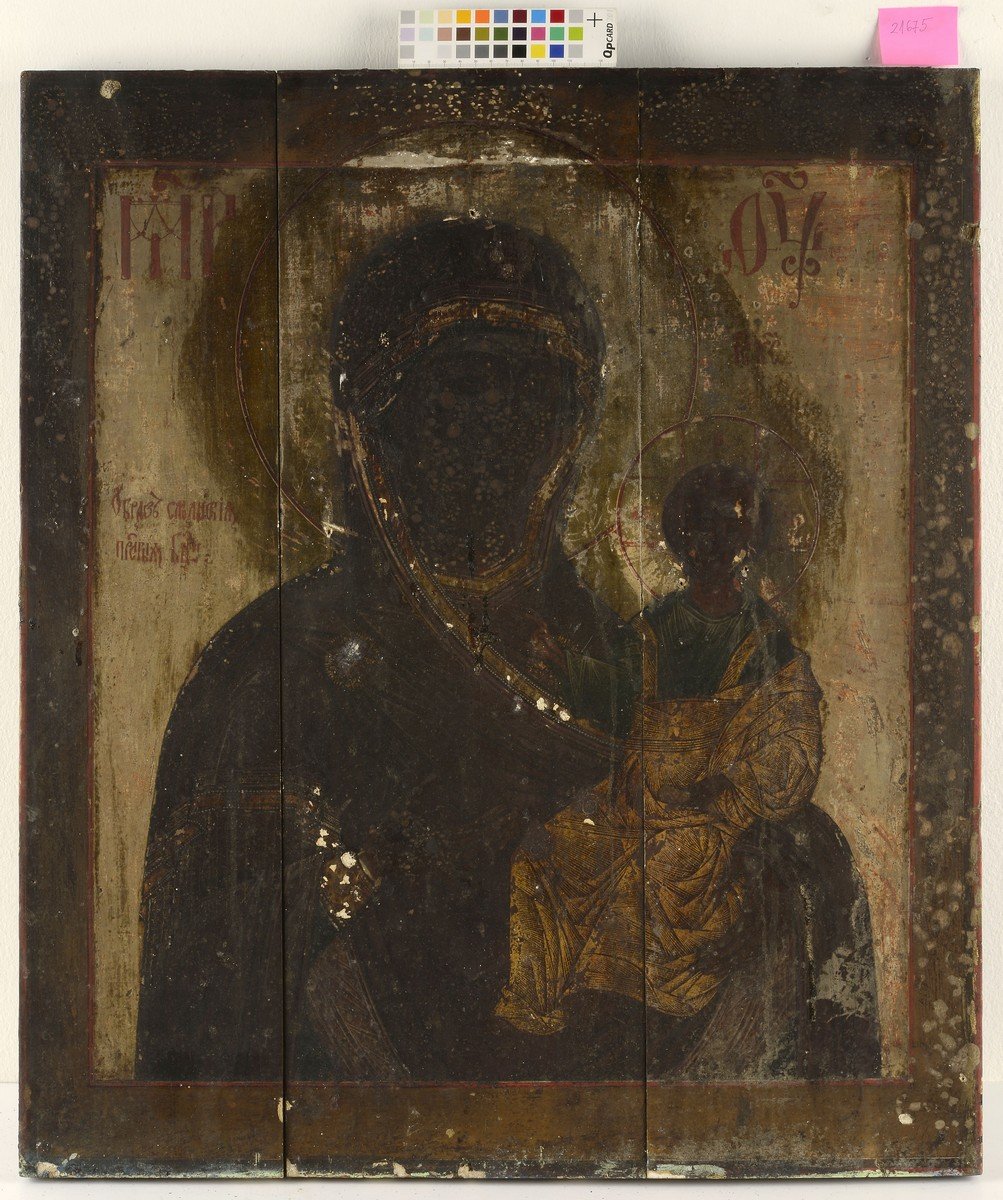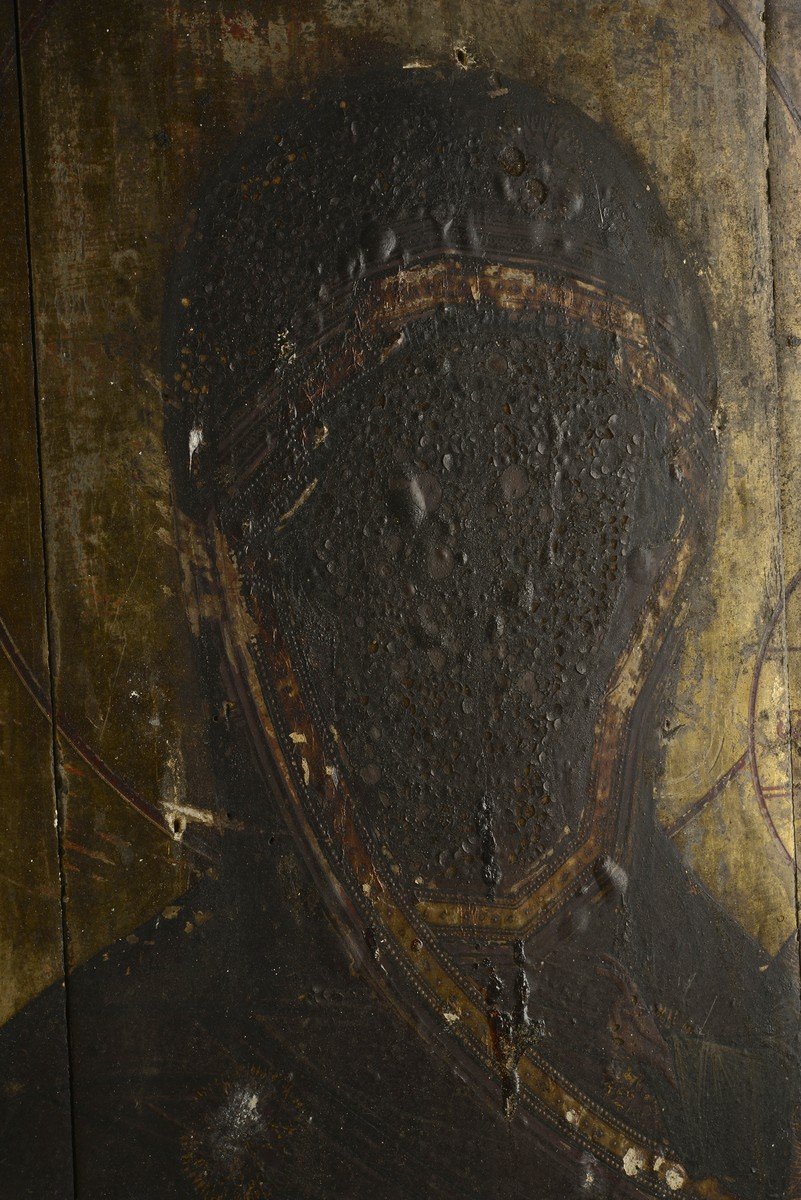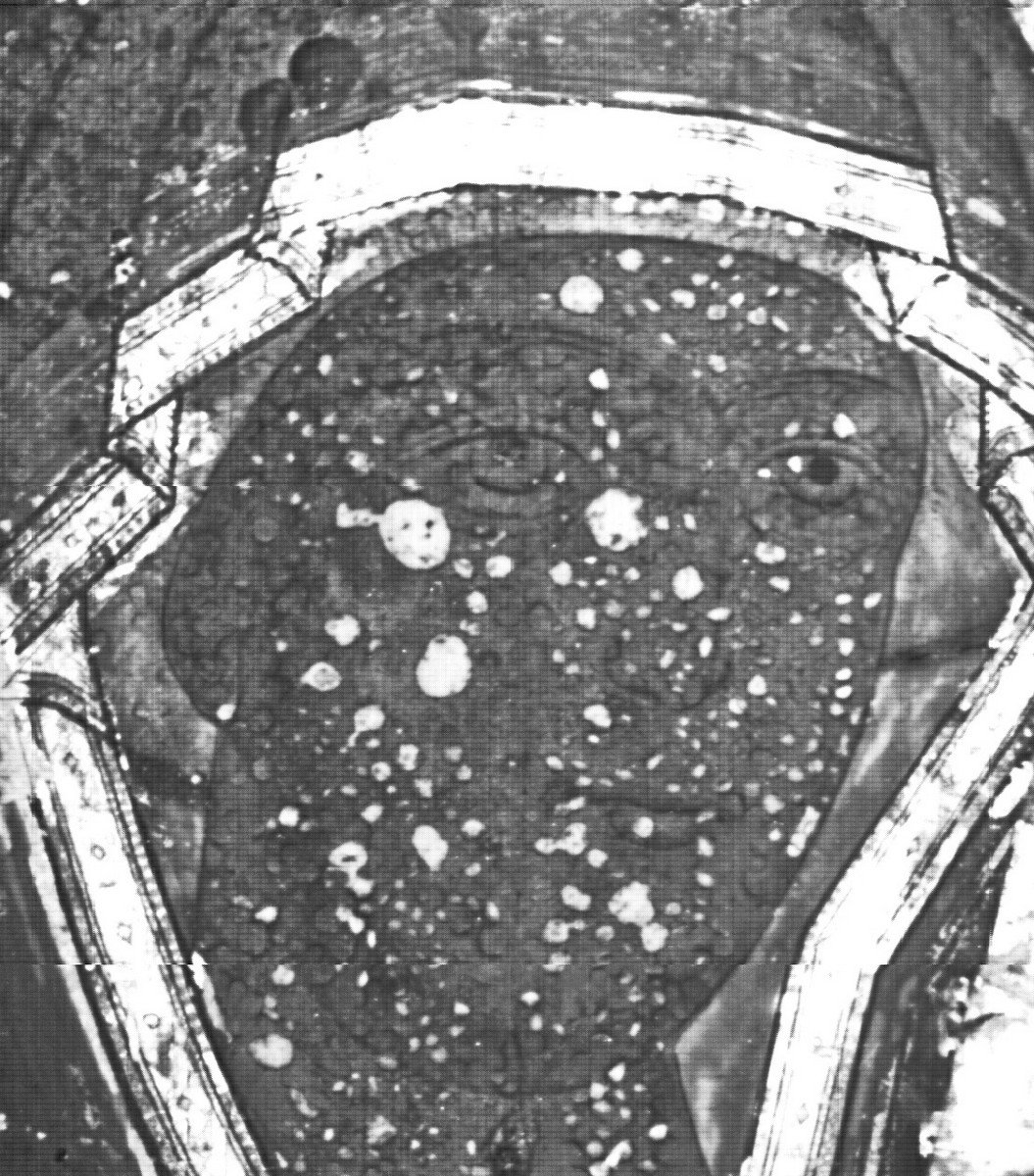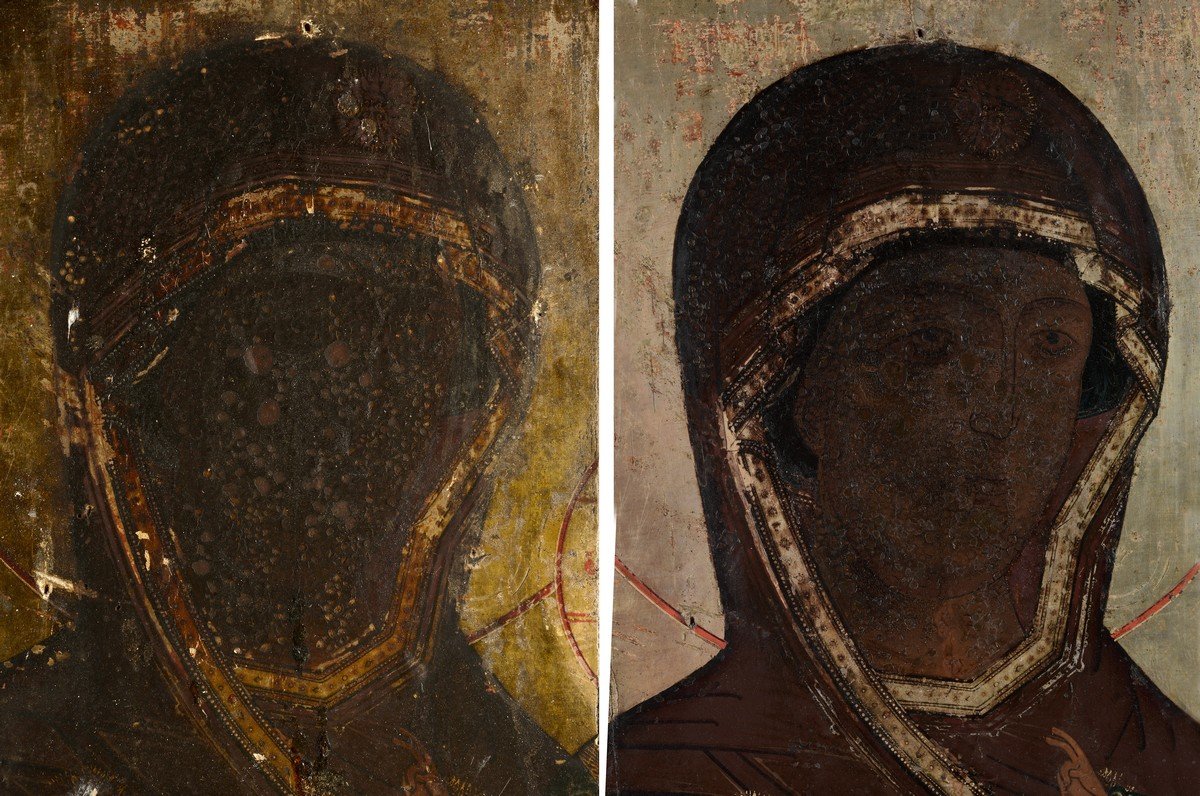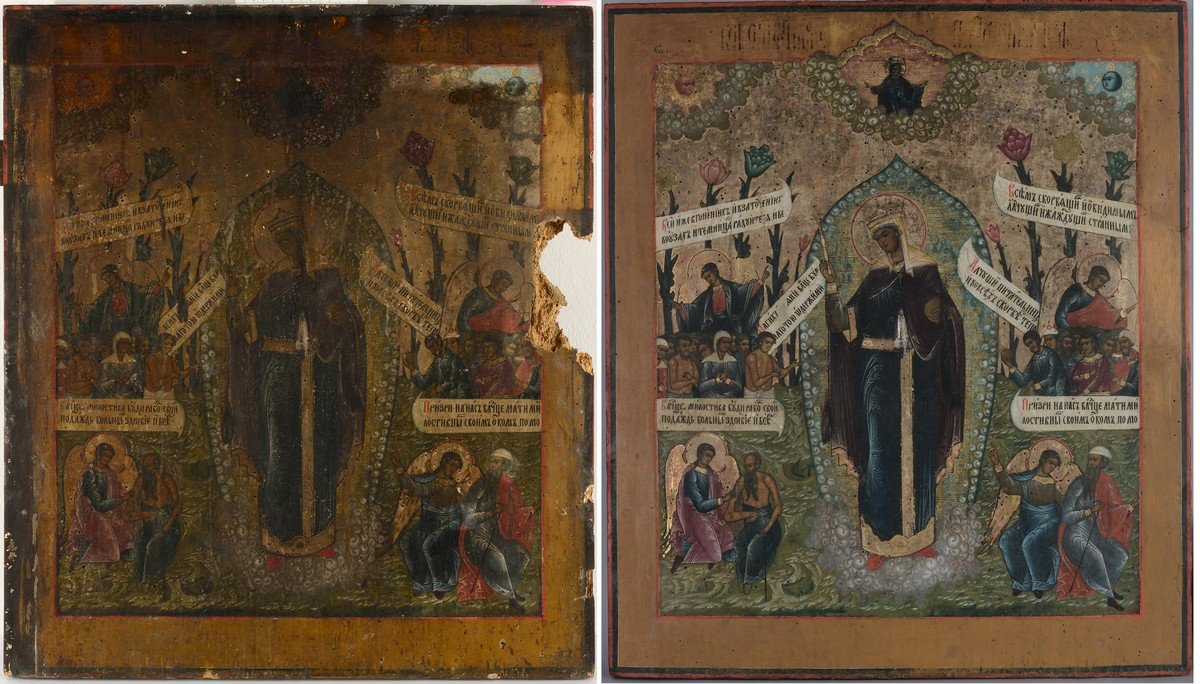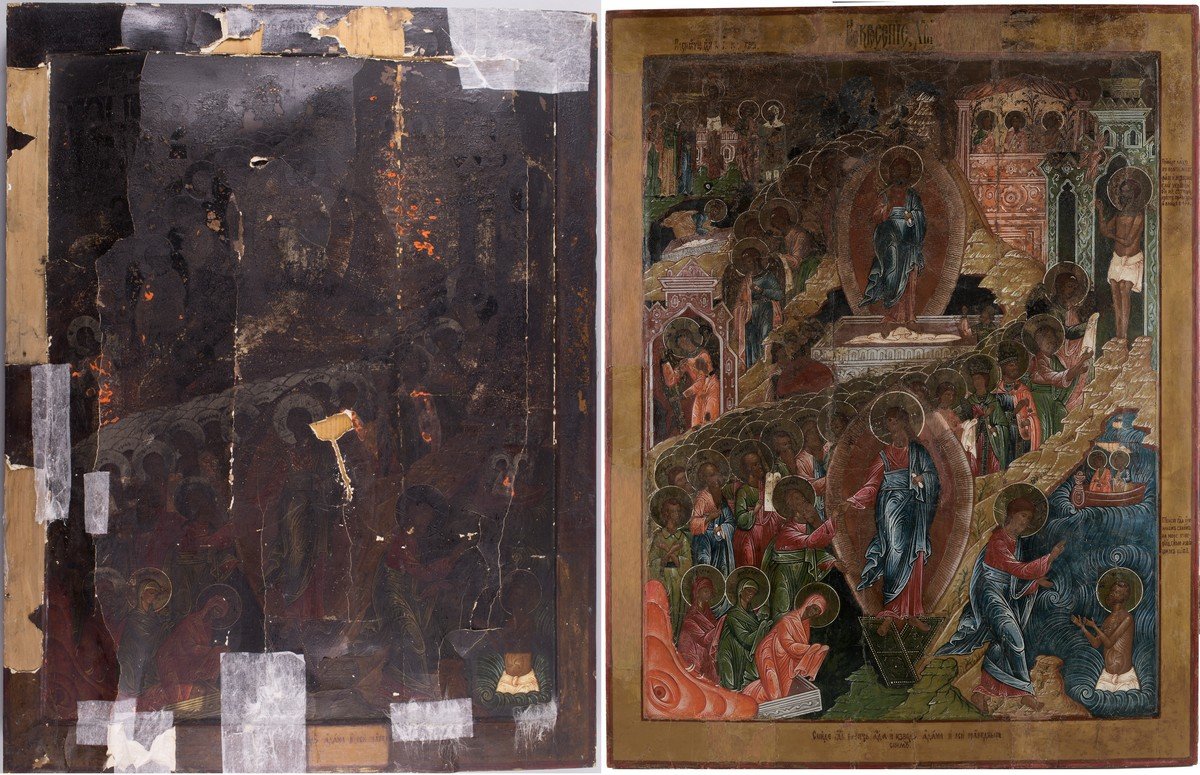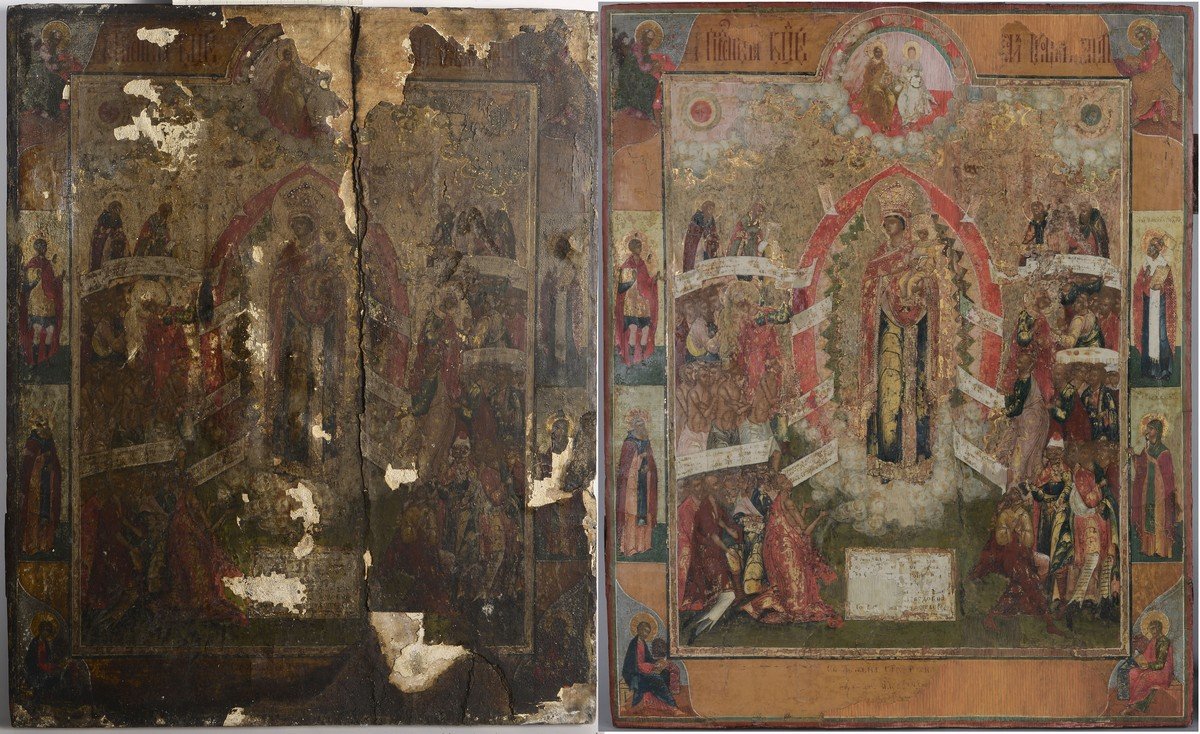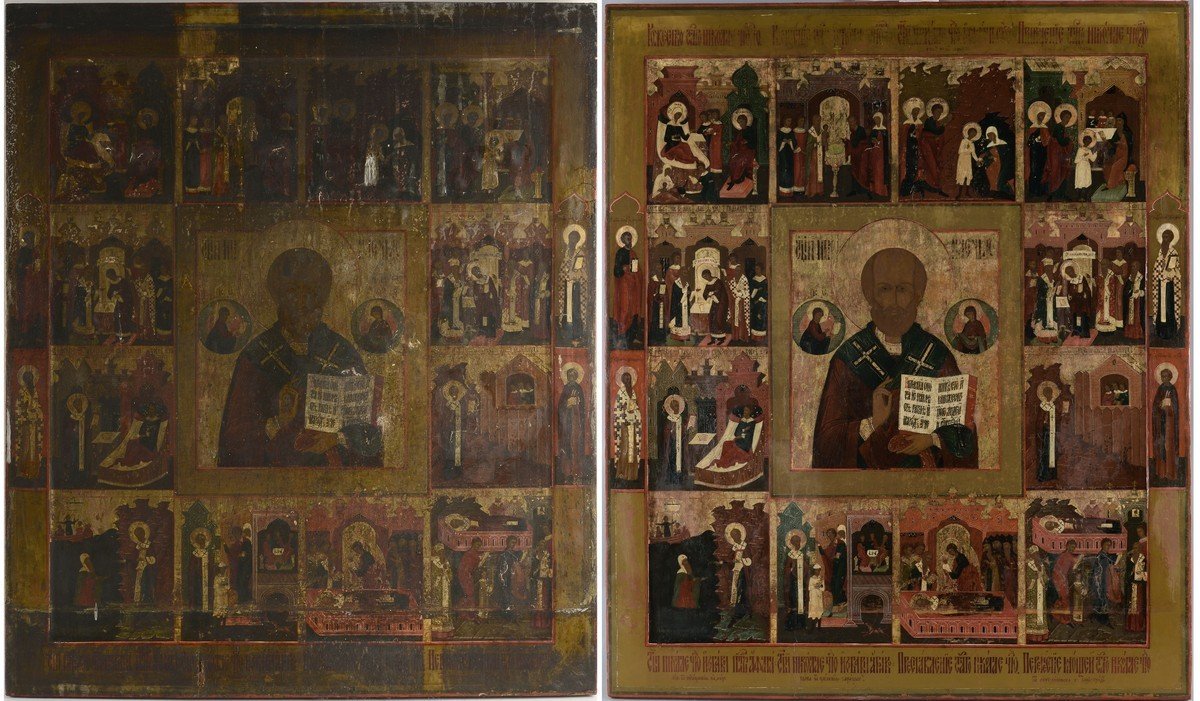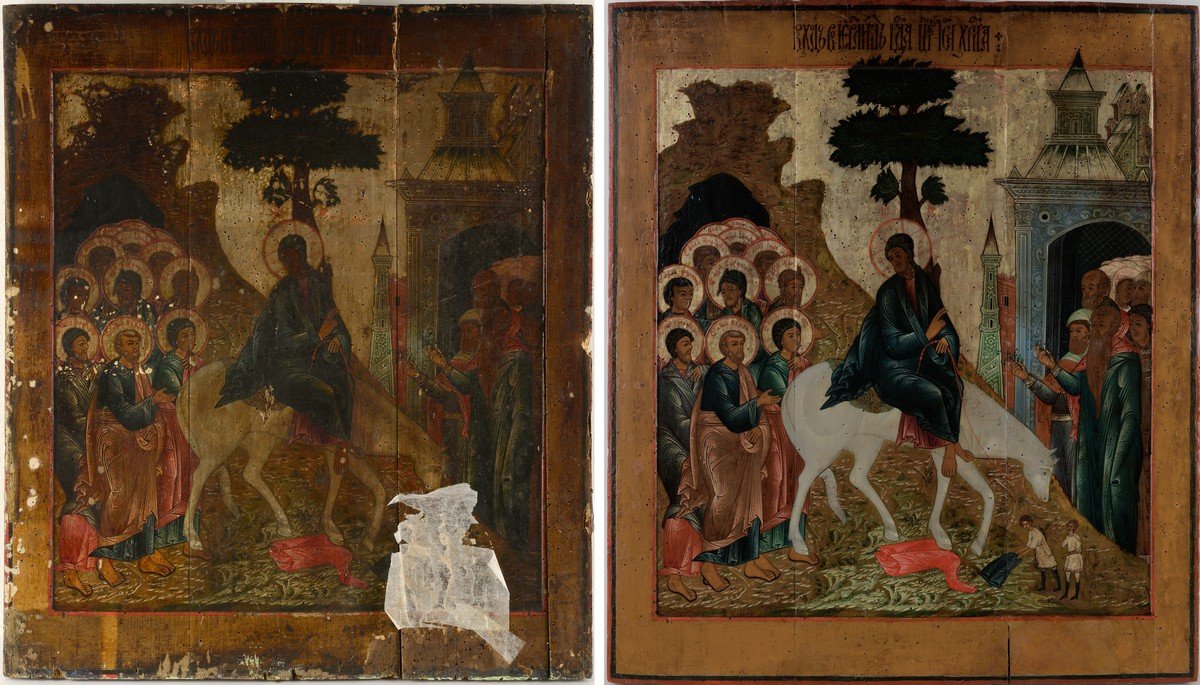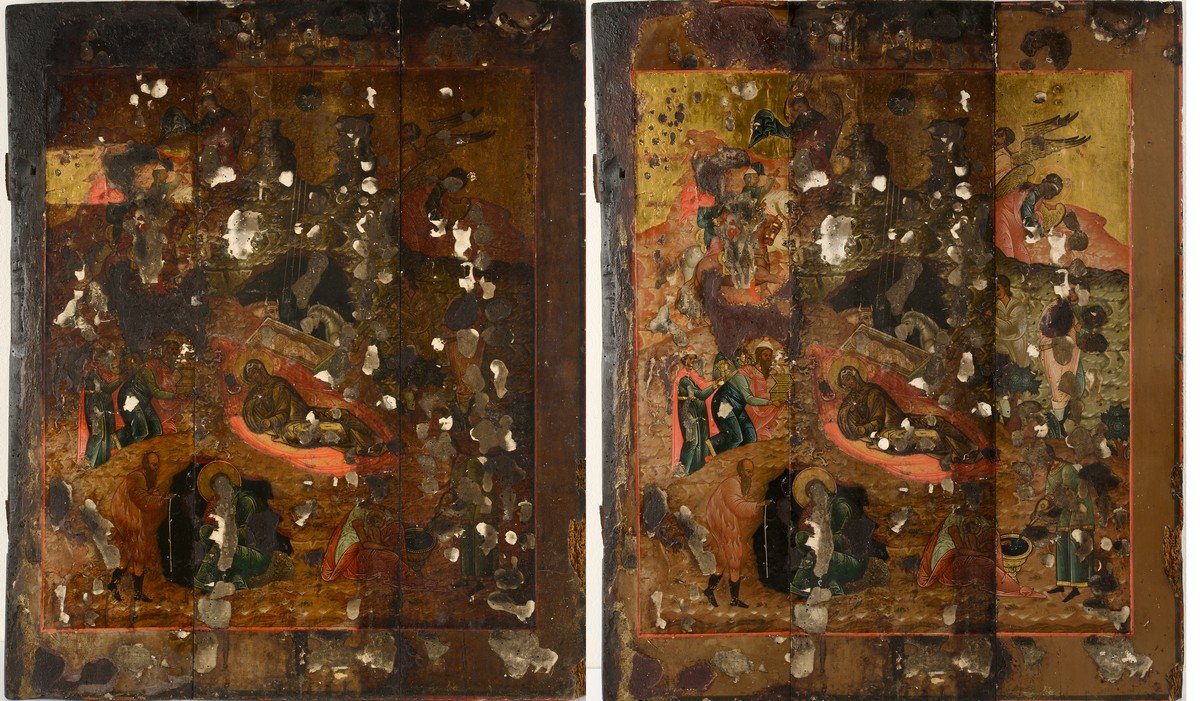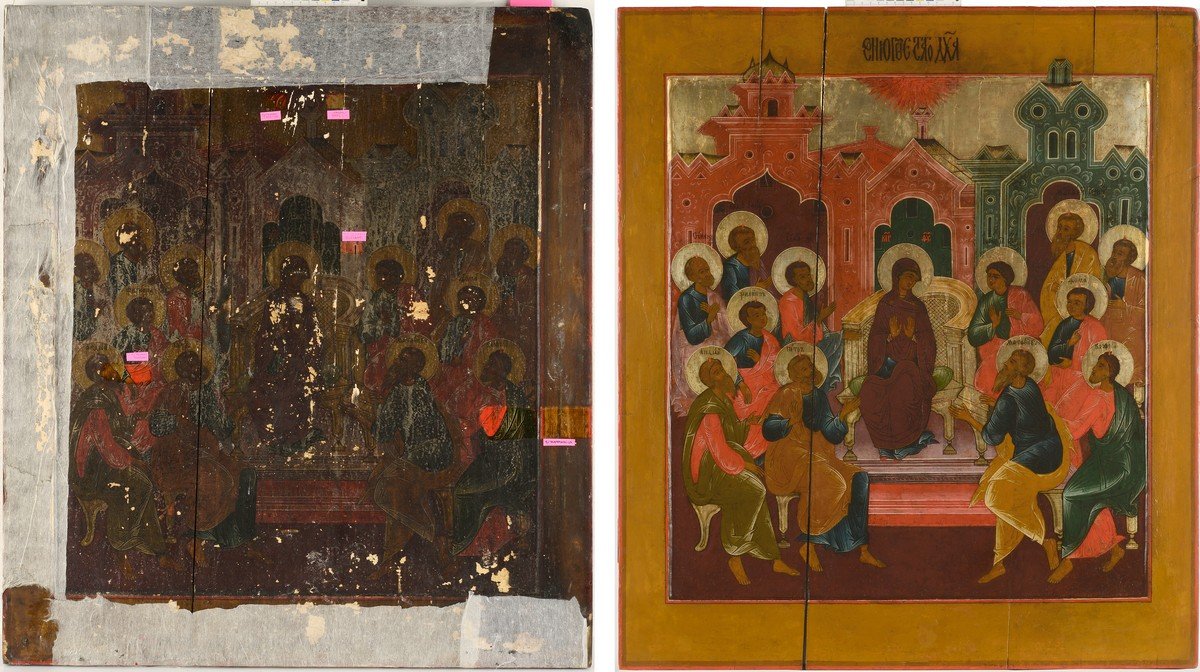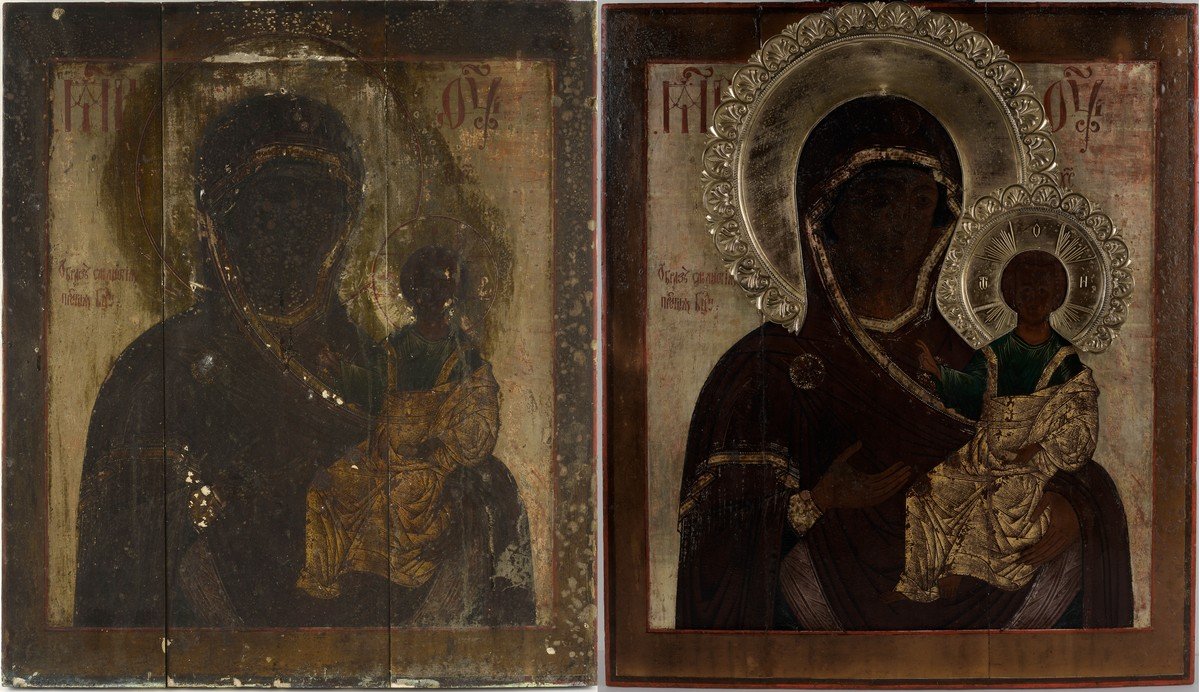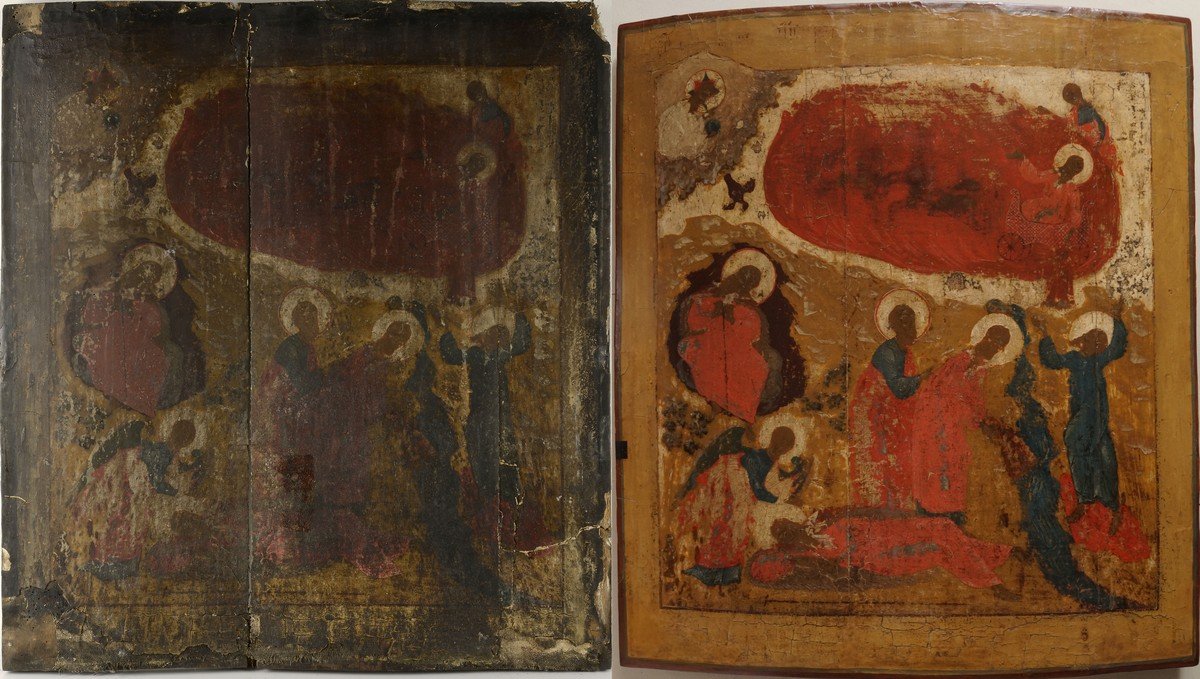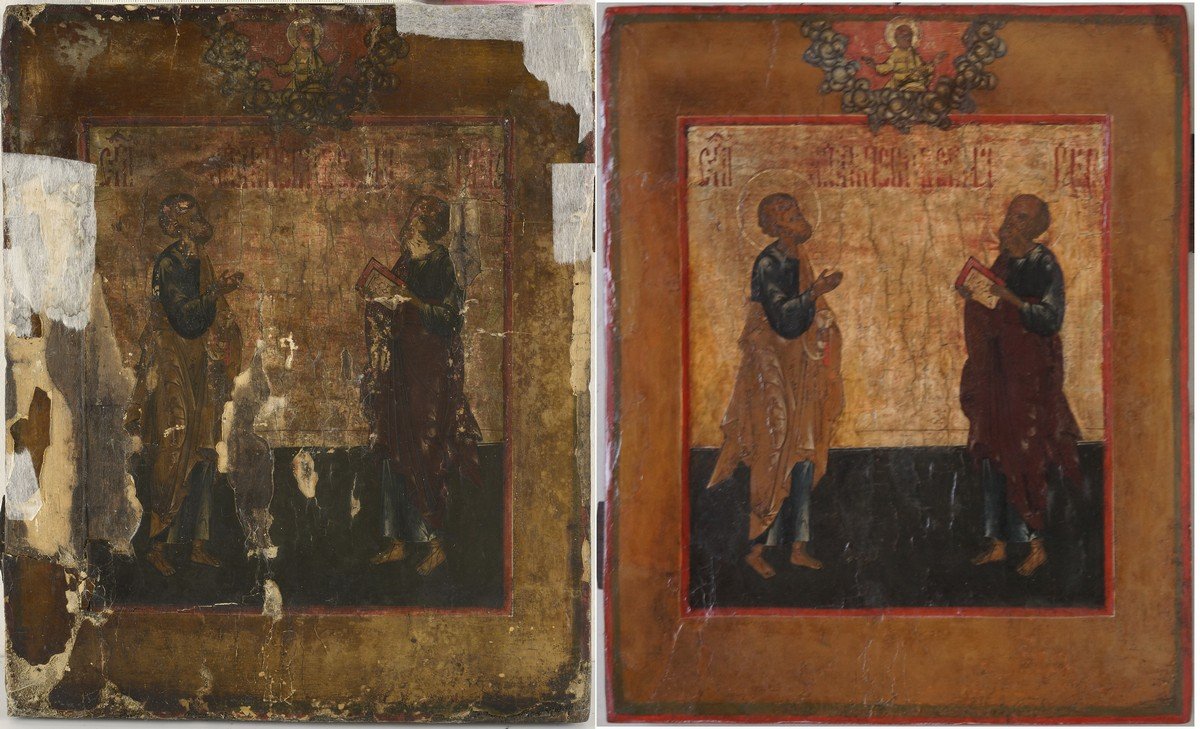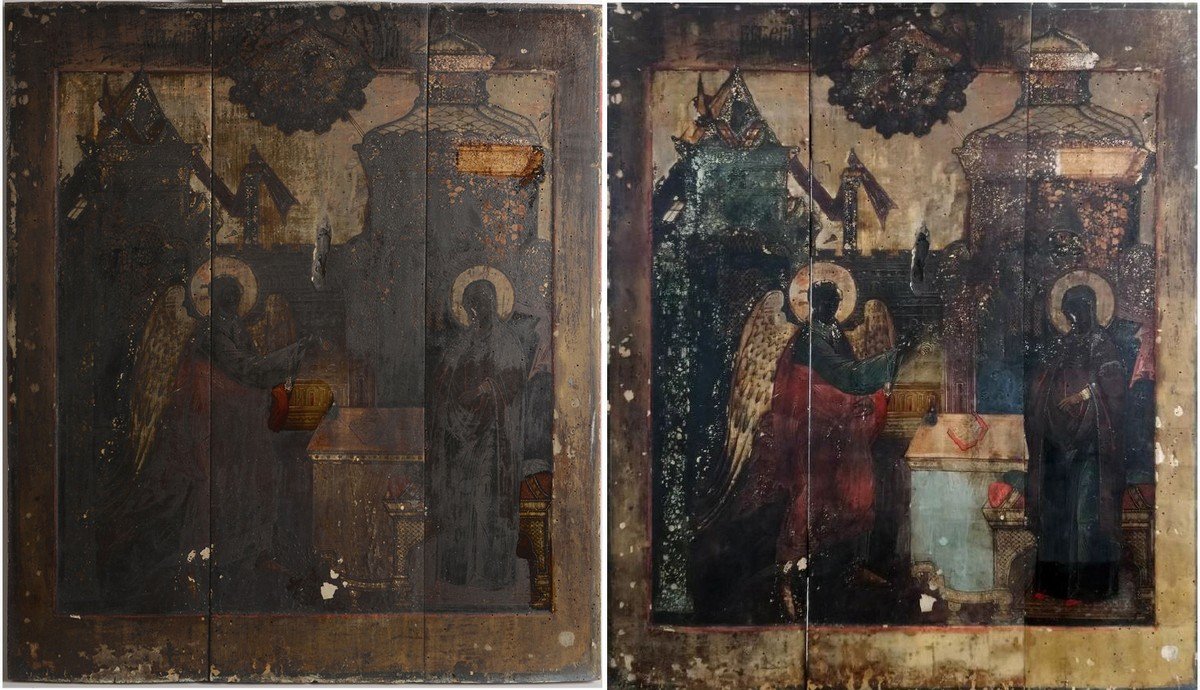ICONS OF THE PIIRISSAARE OLD BELIEVERS’ PRAYER HOUSE – FROM FIRE TO RESTORATION
Autor:
Kristina Aas
Number:
Anno 2019/2020
Category:
Conservation
This article deals with the events that followed the tragic accident in which one of the Estonian Old Believers’ prayer houses caught on fire. The main emphasis lies on the conservation/restoration process of the icons that had been in that building. The dilemmas of finding suitable methods for restoration of two icons as an example have been presented in greater detail. In addition a brief overview presents the destiny of the invaluable bibliographic heritage.
The article also provides a list of all the restored icons with before-and-after photos, including the icons on which the restoration work is still continuing.
The Old Believers’ prayer house and its iconostasis before the fire
The prayer house in Saare village was probably built when the Old Believers’ congregation was registered in the 1920s. viide1 ⁽¹⁾ and it retained its functions until the fire in 2016. It was the only building of worship on the island. The iconostasis had probably not been completed as an entirety. [ill 1] It seems to have been a longer process during which the icons were obtained in different ways, donated by various people, for instance. The icons have been dated to different periods, most of them are from the second half of the 19th up to the first half of the 20th century, but the oldest has been dated to the 17th century. The theme of some icons is repeated, for instance, Mother of God, Joy of All Who Sorrow has been depicted twice. It is known that at least one icon belonged to a private person before becoming a part of the iconostasis. viide2 ⁽²⁾ The author of five icons is known – Mark Solntsev (1899–1957), a student of the well-known icon-painter Gavriil Frolov (1854–1930).
The fire and its consequences
In the early morning, at 1.05 a.m., on 16th of May, 2016 the emergency centre got a phone call that two living-houses are on fire in Saare village, on Piirissaar in Lake Peipus. When the professional fire brigade arrived at the island, three households were already on fire and the roof of the Old Believers’ prayer house had caught fire, too. [ill 2],[ill 3],[ill 4] Firemen who entered the burning prayer house brought out books, icons, crosses and miscellaneous ritual paraphernalia. Several phenomena worked against rescue on this fatal morning – the wind was strong and the traditional way of building on the island (auxiliary buildings are joined to the living-house and all the households are placed closely together) only made the situation harder. The ferry that keeps connection between the island and the mainland was out of order which meant that the firefighters had to find other means of transportation. Most of the people had left the island for work on the mainland, so there was a need for helping hands. The fire was localised at 4.33 a.m. viide3 ⁽³⁾ The prayer house was completely destroyed. Most of the icons, all damaged by the fire, extinguishing water and heat were managed to be brought out from the building.
The prayer house contained 40 art monuments, all under the protection of the state: 31 icons and 3 crosses on wood, one icon and four crosses on metal and one Gospel Book. There were also a lot of objects not listed as items of art monuments. The most noteworthy part of them was the valuable books. viide4 ⁽⁴⁾ All the rescued objects were taken to the auxiliary room of the local waste disposal station. [ill 5] The first task of the advisors of art heritage from National Heritage Board was to list the monuments and determine their situation. 6 of the 32 icons were noted as perished and two of them were lost (they were probably totally destroyed).
The severe condition of the damaged icons demanded immediate action to stop the new damage from appearing. The layers of ground and paint had started to separate due to the heat and extinguishing water. The first stage of emergency work took place in June 2016 – the icons were safely transported to the mainland. viide5 ⁽⁵⁾ Supervised by Viljar Vissel, conservators Üüve Vahur, Marika Mängel and Mart Verevmägi from painting, wood and metal conservation department of the SA Estonian Open Air Museum Conservation and Digitisation Centre Kanut (further on Kanut) properly carried out the evacuation. All the icons and crosses on wood (23 in total) were secured by a facing and transported in special boxes and frames onto the mainland.
Simultaneously with work on icons specialists of the National Archives of Estonia were assessing the damage of the valuable books and deliberating how to stop it spreading. Conservators from the Estonian National Museum, Tartu University Library and Estonian National Library were also engaged in restoring the bindings. viide6 ⁽⁶⁾The Gospel Book that had been registered as the only art monument among the books was conserved at the Kanut.
A month after the fire the National Heritage Board decided to arrange an icon conservation workshop with all the Estonian conservation specialists.
The second stage of emergency work – icon conservation workshop
The five-day workshop took place on the Setu farm at the SA Estonian Open Air Museum on 24–28 October 2016. Over 40 people, conservators from the Open Air Museum, Estonian Museum of Art, Estonian National Museum, Tartu Art Museum and students from Estonian Academy of Arts and Pallas University of Applied Sciences participated in the project [ill 6], [ill 7]. In Estonian context the gathering was rather special – it was the first time ever when professional conservators from all over the country came together to deal with the results of an accident.
Three main aims were set for the icon conservation workshop: viide7 ⁽⁷⁾
Assessing the extent and character of damage;
Recording the damage;
Stabilising the condition of the icons.
Thus it was vital to stop the damage spreading on the icons and balance their current situation. Every icon was assessed separately. Becoming aware of the extent of the damage allowed to plan further work.
As a result of the workshop all the 23 icons were assessed and it became clear that: viide8 ⁽⁸⁾
11 icons could be restored and returned to the prayer house. [ill 8]
4 icons could be restored but the faces of the saints have perished. [ill 9]
on 3 icons the upper part of the painting have perished, but the lower part is preserved. [ill 10]
6 icons have lost the majority of their painting layer. [ill 11]
When the emergency work was completed, all the icons were packed up and taken for storing in three Estonian museums.
Restoration of the icons
Today (summer 2019), 12 icons out of 23 have been restored/conserved or are still being worked on. Some restored icons gave a pleasant surprise. It has become clear that the initial assessment at the above-mentioned workshop was not totally correct. It appeared to be possible to remove some or the entire charred layer. Thick layer of oil varnish has protected the paint layers from heat and even the straight flames. The layer of traditional varnish based on linseed oil has been, so to say, on the fire-line. The layers of paint underneath may have changed/tarnished but are still readable. This discovery has been already made on two of the icons, increasing the hope that the other icons initially considered perished might still yield to restoration.
Resurrection with descending into Hell, Mark Grigoryevich Solntsev. [ill 12]
The observation record from 16th of May 2016 states that the icon is considered to be perished. According to the report from the conservation workshop “the upper part of the painting has evidently perished but the lower part has preserved”. [ill 13]
The icon was chosen as a sort of restoration model to see to which extent restoration is possible with the icons that were partly destroyed. Eight more icons are in the same condition. It was expected to create a precedent for further decisions on dealing with the same kind of damage. The concept of restoration was based on the object as a piece of art and not as a sacred object, thus the aim was to restore the visual entity of a painting.
Getting on with the cleaning of the surface step by step it began to appear that it is possible to cleanse even the upper part of the icon, that earlier had been considered totally perished. [ill 14] Having completed the cleansing it became clear that the surface beneath the coating had mostly preserved. This demanded rethinking of the initial restoration concept. Icon was still treated as a piece of art and not as a sacred object. For the further works two main value categories were followed – historical and esthetical one. The latter means the visual readability of the piece and its author’s proficiency. The historical aspect is concerned with the author, place, time, authenticity and originality of the piece. With respect to the authenticity of the piece and the author’s original layers, certain principles were followed in order to prevent the conservator from taking liberties. The third principle was added to the first two – as extensive losses in the layers of grounding and paint existed, [ill 15] it was decided that the conservator’s interference should be visually noticeable but, at the same time, not so visible from the point of the painting’s entirety. viide9 ⁽⁹⁾
This dictated the decision to retouch the losses with watercolours in trateggio technique. [ill 16], [ill 17] Discussions with the National Heritage Board led to the conclusion that this solution should not hinder using the icon in its sacral function. In trateggio, as based on a principle of Cesare Brandi’s philosophy, historical and esthetical dimensions are considered equal. When the icon is used for sacral purposes the historical dimensions and authenticity are not important but they are significant in the aspect of an art monument. Retouching in trateggio technique means using fine lines, parallel to each other in primary colours (red-yellow-blue) integrating them layer by layer to the same tonality as the surrounding original. [ill 18] This makes the retouching optically the same with the original at a distance and gives the idea of pictorial entity [ill 19]. At close viewing, however, the restorer’s work is separable from the original.
Our Lady of Smolensk, school of G.J. Frolov [ill 20]
The essence of an icon depends on its appearance. When the appearance changes then the characters of an icon do not work for the purpose anymore and its sacral function disappears. A believer does not find solace in an icon the image of which has been destroyed. The Virgin Mary with a burnt face would not take the believers onto higher spiritual planes but rather gives them a gruesome feeling. Linda Lainvoo – Director of Art Heritage Field at the National Heritage Board, presented a good comparison in one of her after-the-fire interviews – just like we have not shown the burnt icons from the Piirissaare prayer house, the public never sees photos of people perished in car-crashes. viide10 ⁽¹⁰⁾
The following can be found in the report on the second stage of emergency work: “The layer of paint in the face area has turned dark from the heat and detached from the grounding”. [ill 21] The restoration of the previous icon described above, awakened hope that there might be something left of the Virgin’s face under the charred layer. Infrared photos that showed the contours of the eyes, nose and mouth rather clearly encouraged further on. [ill 22] When the charred layer was being removed these contours became quite clear. The heat had destroyed the gradation of the colours but the visage of the Virgin was completely readable. [ill 23]
What will happen to the icons further on? Director of Art Heritage Field Linda Lainvoo said that the final (ideal) aim is to display the icons again in the Piirissaare prayer house in their original context. But the prayer house is not there any longer and nobody knows whether a new one will be built and if it is, when. What will happen to icons which are not usable for religious purposes any longer? Several ideas have been offered starting with arranging an exhibition up to founding a museum. It should be deliberated together with the local congregation what to do with icons that have been damaged so seriously that they have lost their sacral functions, but that have still preserved to this extent that some of their characteristics of art monuments have survived. There is actually no scale that would allow determining universal characters and non-characteristic features of an art monument. To declare an object a non-monument demands deliberation and discussions that do not bring a consensus. Such decisions are rather rare in the practice of the National Heritage Board. Linda Lainvoo thinks that an art monument remains a monument even if only a fragment of it has survived.
The fire caused a rise in public interest that, in its turn, helped to explain the particularities in the operations of the National Heritage Board. The media helped to educate the general public about the art monuments in Estonia and the dangers facing them. The media interest also gave the officials who, more often than not, have been reflected in a rather negative way, an opportunity to prove the significance of the role they have in the protection of art monuments. A noteworthy part of the Piirissaare heritage was rescued only thanks to the immediate reaction from the National Heritage Board. The fate of the icons would have been much more tragic if they had not had the status of art monuments, protected by the state.
Icons already restored or still worked on at the Kanut
Mother of God, Joy of All Who Sorrow, no of reg. 21664 [ill 24]
Conservator – Kristina AasResurrection with Descent to Hell, no of reg. 21667 [ill 25]
Conservator – Kristina AasMother of God, Joy of All Who Sorro with the four Evangelists, no of reg. 21668 [ill 26]
Conservator – Kristina AasTwelve Scenes from the life of Nicholas the Miracle-Worker and four saints, no of reg. 21665 [ill 27]
Conservator – Ingrid PihelgasThe Entry into Jerusalem, no of reg. 21656 [ill 28]
Conservator – Marika MängelNativity, no of reg. 21663 [ill 29]
Conservator – Üüve VahurEffusion of the Holy Spirit, no of reg. 21670 [ill 30]
Conservator – Marika MängelOur Lady of Tihvin, no of reg. 21662 [ill 31]
Conservator – Egle Mikko viide11 ⁽¹¹⁾ Supervisors – Marike Laht and Mariliis VaksOur Lady of Smolensk, no of reg. 21657 [ill 32]
Conservator – Kristina Aas
Restored outside the Kanut
Prophet Eliah, no of reg. 21666 [ill 33]
Conservator – Malle-Reet HeidelbergApostle Peter and Paul, no of reg. 21680 [ill 34]
Conservator – Malle-Reet HeidelbergAnnunciation of Virgin Mary, no of reg. 21660 [ill 35]
Conservator – Kristel-Kai Kooskora viide12 ⁽¹²⁾ Supervisors Marike Laht and Merike Kallas
Viited
J.Plaat, Vene vanausulised ja nende pühakojad Eestis. (Russian Old Believers and their houses of worship in Estonia.) Tallinn: Tallinna Raamatutrükikoda, 2016, pp 114-119. ↩︎
Kultuurimälestiste riiklik register (The Register of Cultural Heritage), https://register.muinas.ee/public.php?menuID=monument&action=view&id=21668
(viewed11.06.2019) ↩︎Piirissaarel hävis tules kolm elumaja ja vanausuliste palvemaja (Three living-houses and the Old Believers’ house of worship perished in fire on Piirissaar), (Delfi Rahva Hääl 16.05 2016, http://rahvahaal.delfi.ee/news/pildid/fotod-sundmuskohalt-piirisaarel-havis-tules-kolm-elumaja-ja-vanausuliste-palvemaja?id=74533719 (viewed on 11.06.2019). ↩︎
The inspector general of the National Heritage Board, Linda Lainvoo’s record after the fire and mail-correspondence with the senior inspector Grete Nilp. ↩︎
81MKA, A-12728: Tartu County, Piirissaare Civil Parish, Piiri village. Plan for the conservation of memorials from Piirissaare Old Believers’ house of worship. Tule- ja vee kahjustused kunstiteosel – konservaator kui päästja (Conservator as a rescuer in case of fire and water damage on a relic of art), 2016. ↩︎
Rescue and conservation of books from the Piirissaare house of worship – National Archives’ blog, 9.09.2016, http://blog.ra.ee/piirissaare-palvemaja-raamature-paastmin-ja-konserveerimine/ (viewed on 14.06.2019). ↩︎
MKA, A-12728: Tartu maakond, Piirissaare vald, Piiri küla, Piirissaare vanausuliste palvela kunstimälestiste konseveerimistööde tegevuskava. Tule- ja vee kahjustus kunstiteosel – konservaator kui päästja ( Damage of fire and water on a relic of art – conservator as a rescuer), 2016 ↩︎
MKA, A-12754: Tartu maakond, Piirissaare vald, Piiri küla, Piirissaare vanausuliste palvela kunstimälestised. Konserveerimistööde aruanne. Avariitööde II etapp, 2016. (Report on the conservation. The 2nd stage of the emergency work) ↩︎
K. Aas, Piirissaare vanausuliste palvela ikoonid – põlengust restaureerimiseni. Magistritöö (Icons of the Piirisaare Old Believers’ house of worship from the fire up to restoration. MA thesis). Tallinn: Eesti Kunstiakadeemia Muinsuskaitse ja konserveerimise osakond, 2018. ↩︎
The inspector general of art monuments – ‘our houses of worship are rich indeed in relics of art’ –Terevisioon, ETV, https://etv.err.ee/v/ meelelahutus/terevisioon/terevisiooni_lood/8d82488b-fded-4235-b96b-ee5fb43859c3/kunstimalestiste-peainspektor-meie-kirikud-on-vaga-rikkad-kunstimalestiste-poolest (viewed on 06.11.2019). ↩︎
E. Mikko, “Tihvini Jumalaema” ikooni uuringud ja konserveerimine. Lõputöö. Tartu: Tartu Kõrgema Kunstikooli maaliosakond, 2017. ↩︎
K-K. Kooskora, Ikooni”Maarja Kuulutus” konserveerimine. Lõputöö. Tartu: Tartu Kõrgema Kunstikooli maaliosakond, 2018. ↩︎




